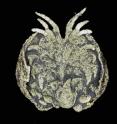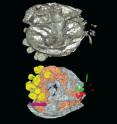Parental care of the young from 450 million years ago
Related images
(click to enlarge)
A portrait of prehistoric parenthood captured deep in the fossil record has been uncovered by an international team of scientists led by University of Leicester geologist Professor David Siveter. The 'nursery in the sea' has revealed a species new to science -- with specimens preserved incubating their eggs together with probable hatched individuals. As a result, the team has named the new species Luprisca incuba after Lucina, goddess of childbirth, and alluding to the fact that the fossils are ancient and in each case the mother was literally sitting on her eggs.
The find, published in the journal Current Biology, provides conclusive evidence of a reproductive and brood-care strategy conserved for at least 450 million years. It also represents the oldest confirmed occurrence of ostracods in the fossil record.
Professor Siveter, Emeritus Professor of Palaeontology at the University of Leicester, said: "This a very rare and exciting find from the fossil record. Only a handful of examples are known where eggs are fossilized and associated with the parent. This discovery tells us that these ancient tiny marine crustaceans took particular care of their brood in exactly the same way as their living relatives."
The team from the UK, USA and Japan has discovered a new and scientifically important species of a fossil ostracod- an animal group related to shrimps, lobsters and crabs -- in mudstone rocks from New York State, USA, dating back to the Ordovician period of geological time. Ostracods are tiny crustaceans known from thousands of living species in oceans to rivers, lakes and ponds today and from countless fossil shells.
The newly discovered fossils are two to three millimetres long and are especially informative because they are exceptionally well preserved, complete with not only the shell but also the soft parts of the animal that in all but very rare cases are lost to the fossil record. Limbs and in some specimens a clutch of eggs are present within the bivalved shell, enabling the scientists to identify and gender such specimens. These anatomical features were preserved in the mineral pyrite, which facilitated the use of x-ray techniques to reveal morphological details hidden within the shells and the rock.
Professor Siveter, of the University of Leicester's Department of Geology, together with researchers from the universities of Yale and Kansas, USA, Oxford, UK, and the Japan Agency of Marine Science and Technology, discovered the tiny arthropods.
The ostracods lived, together with other invertebrate animals such as trilobites, in poorly oxygenated conditions in a sea bordering the margins of the ancient North American continent. Professor Siveter said that, like their modern relatives, the ostracods were probably capable of swimming near the sea bed and obtained their food by scavenging and hunting.
Source: University of Leicester
Other sources
- Fossil discovery unearths 'nursery in the sea'from CBC: Technology & ScienceFri, 14 Mar 2014, 19:00:10 UTC
- New fossil species reveals parental care of young from 450 million years agofrom Science DailyThu, 13 Mar 2014, 18:01:20 UTC
- Parental care of the young from 450 million years agofrom PhysorgThu, 13 Mar 2014, 16:30:12 UTC

